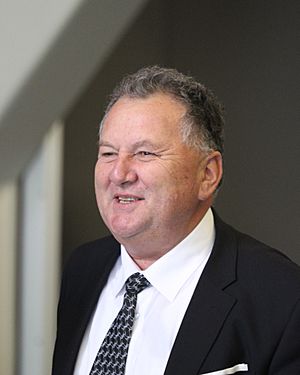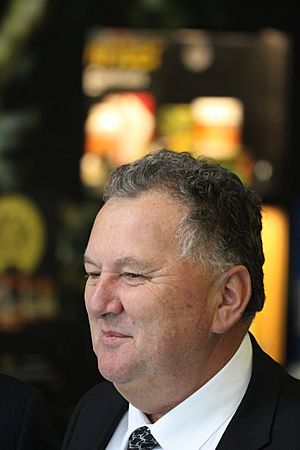Shane Jones facts for kids
Quick facts for kids
Shane Jones
MP
|
|
|---|---|

Jones in April 2018
|
|
| 14th Minister for Oceans and Fisheries | |
| Assumed office 27 November 2023 |
|
| Prime Minister | Christopher Luxon |
| Preceded by | Rachel Brooking |
| 3rd Minister for Infrastructure | |
| In office 26 October 2017 – 6 November 2020 |
|
| Prime Minister | Jacinda Ardern |
| Preceded by | Steven Joyce |
| Succeeded by | Grant Robertson |
| 31st Minister for Forestry | |
| In office 26 October 2017 – 6 November 2020 |
|
| Prime Minister | Jacinda Ardern |
| Preceded by | Vacant (last held by David Carter) |
| Succeeded by | Stuart Nash |
| 1st Minister for Regional Economic Development | |
| In office 26 October 2017 – 6 November 2020 |
|
| Prime Minister | Jacinda Ardern |
| Succeeded by | Stuart Nash |
| Minister for Building and Construction | |
| In office 31 October 2007 – 19 November 2008 |
|
| Prime Minister | Helen Clark |
| Preceded by | Clayton Cosgrove |
| Succeeded by | Maurice Williamson |
| Member of the New Zealand Parliament for New Zealand First list |
|
| Assumed office 14 October 2023 |
|
| In office 23 September 2017 – 17 October 2020 |
|
| Member of the New Zealand Parliament for Labour Party list |
|
| In office 17 September 2005 – 22 May 2014 |
|
| Succeeded by | Kelvin Davis |
| Personal details | |
| Born | 3 September 1959 Awanui, New Zealand |
| Political party | NZ First (2017–present) |
| Other political affiliations |
Labour (2005–2017) |
| Spouses |
|
| Children | 7 |
| Alma mater | |
Shane Geoffrey Jones (born 3 September 1959) is a politician from New Zealand. He is a member of the New Zealand House of Representatives for the New Zealand First party. A politician who is a Member of Parliament (MP) helps make laws for the country.
Jones began his political career in 2005 with the Labour Party. He quickly became a cabinet minister, which is a senior government leader. He served as the Minister for Building and Construction. After Labour lost the 2008 election, he became a senior member of the opposition.
In 2014, he left politics for a short time to work as a diplomat. He returned in 2017 as an MP for the New Zealand First party. From 2017 to 2020, he was the Minister for Regional Economic Development and Minister of Forestry. Since 2023, he has served as the Minister for Oceans and Fisheries, Minister for Regional Development, and Minister for Resources.
Contents
Early Life and Education
Shane Jones was born in Awanui, near Kaitaia, New Zealand. He was the oldest of six children. His father, Peter, was a farmer, and his mother, Ruth, was a teacher. Jones is Māori, with family roots from the Te Aupōuri and Ngāi Takoto iwi (tribes). He also has English, Welsh, and Croatian ancestors.
For high school, Jones went to St Stephen's School, a boarding school for Māori boys. He later studied at Victoria University of Wellington. In 1990, he received a special scholarship to study at Harvard University in the United States, where he earned a Master's degree. He is fluent in the te reo Māori.
Before becoming a politician, Jones worked for the government. He advised on Treaty of Waitangi issues. The Treaty of Waitangi is a founding document of New Zealand. He also became the chairman of the Treaty of Waitangi Fisheries Commission, which manages fishing resources for Māori iwi.
Political Career
| New Zealand Parliament | ||||
| Years | Term | Electorate | List | Party |
| 2005–2008 | 48th | List | 27 | Labour |
| 2008–2011 | 49th | List | 16 | Labour |
| 2011–2014 | 50th | List | 16 | Labour |
| 2017–2020 | 52nd | List | 8 | NZ First |
| 2023–present | 54th | List | 2 | NZ First
|
Jones has been elected to Parliament for two different political parties. He started with the Labour Party from 2005 to 2014. He then joined New Zealand First and has been an MP with them since 2017.
Jones has said he did not always feel comfortable in the "modern Labour Party." He has a close relationship with New Zealand First leader Winston Peters, which was one reason he joined that party in 2017.
First Years in Parliament (2005–2008)
In 2005, Jones was elected to Parliament as a list MP for the Labour Party. A list MP is chosen from a party's list of candidates, not by winning a specific geographic area.
Because of his high ranking on the party list, he entered Parliament and was immediately made a committee chairperson. In 2007, he was promoted to Cabinet as the Minister for Building and Construction.
Time in Opposition (2008–2014)
After Labour lost the 2008 election, Jones became an opposition MP. This means his party was not in power, and his job was to challenge the government's decisions. He held several important roles in the "shadow cabinet," which mirrors the roles of the actual government ministers.
During this time, Jones faced some controversies. In 2010, he was demoted by his party leader for misusing his ministerial credit card. In 2012, he stepped down from his roles while an investigation looked into a citizenship application he had approved. The investigation later found he had not acted improperly.
In 2013, Jones ran for the leadership of the Labour Party but was not successful. The next year, he announced he was leaving Parliament to take a job as a Pacific Economic Ambassador.
Joining New Zealand First (2017–2020)

In 2017, Jones returned to politics as a candidate for the New Zealand First party. He was elected as a list MP. After the election, New Zealand First formed a coalition government with the Labour Party. This means the two parties agreed to work together to govern the country.
As part of this government, Jones became a minister again. He was in charge of the Provincial Growth Fund, a $3 billion fund to help develop different regions of New Zealand. The fund was used for projects like upgrading rail lines and ports.
Jones became known for his outspoken and sometimes controversial comments. In 2019, he made remarks about the Indian community in New Zealand that were criticized by other politicians. He also made comments about climate change activists and farmers that drew criticism.
Return to Parliament (2023–present)
In the 2020 election, New Zealand First did not get enough votes to stay in Parliament. Jones lost his seat and spent the next three years out of politics.
He returned for the 2023 election and was once again elected as a list MP for New Zealand First. The party formed a new coalition government with the National Party and the ACT party.
In this government, Jones was appointed to several ministerial roles, including Minister for Oceans and Fisheries and Minister for Resources. In early 2024, he announced that the government would reverse a ban on new oil and gas exploration. He argued this would help the economy.
In early 2025, Jones was criticized for shouting "Send the Mexicans home!" during a debate in Parliament. The comment was condemned by other politicians, and the Prime Minister advised MPs to "watch their language."
Political Views
Social Issues
Jones has voted on several important social issues. In 2013, he voted in favour of legalizing same-sex marriage in New Zealand. He also supported the End of Life Choice Act 2019, which allows for assisted dying in certain situations.
Māori Issues
Jones has often spoken about issues important to Māori. In 2024, he defended the government's plan to review the principles of the Treaty of Waitangi. He said that institutions need to be reviewed over time. He also stated that his party, NZ First, would not support the government's proposed Treaty Principles Bill past its first reading in Parliament.
Tobacco Industry
Jones has faced questions about his relationship with the tobacco industry. His party, New Zealand First, successfully pushed for the repeal of laws that were aimed at creating a smoke-free generation.
Personal Life
Jones has seven children with his first wife, Ngāreta, who passed away in 2015. In 2018, he married Dorothy (Dot) Pumipi.
In April 2025, Jones and his wife were involved in a confrontation with a man at Auckland Airport. The couple filed a police report after the incident.


